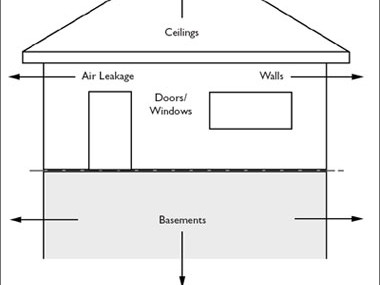In our energy efficiency series of articles that we feature each Thursday we have been focusing on strategies for making your new home energy efficient. Of course plans for your new home may be on the horizon and you may look at improving the value of your existing home by an energy-efficient retrofit. Where to begin? The CMHC has a series of fact sheets addressing this very topic.
The building envelope is the outer layer of the building that separates the living space from the outdoor environment, both above and below grade. Many older homes have high heating requirements because of high rates of air leakage and building envelope areas that are not well insulated.
Like any renovation, retrofitting the building envelope requires careful planning. Before you decide to go ahead with the project, it is important to clearly identify the areas that you want to improve. Just as important is a thorough inspection of the existing structure so that any current problems can be corrected.
Common Situations
Many homeowners suffer for years, living in houses that are cold, drafty or have high heating bills, especially on windy days during the heating season. The process of improving the energy efficiency of the entire building envelope can seem like an overwhelming task. An understanding of the principle that the house functions as a system (see the House as a System section) is critical for anyone undertaking a building envelope retrofit. Prioritizing the different aspects of the work and learning about viable retrofit techniques can help you to work through the many decisions that must be made.
To help you recognize problems and to plan an energy-efficient retrofit, consider these important areas:
- Assessing the building — the house may be cold, drafty and expensive to heat. A thorough assessment of the building envelope is critical and will help you to prioritize the different aspects of the work.
- Structural problems — there may be structural or water leakage problems. Any existing problems and damage must be repaired as part of the retrofit project.
- Building envelope components — the building envelope may be poorly insulated, leaky or energy inefficient. Understanding the options available for upgrading the various elements of the building envelope requires research or professional help.
- Moisture — there may be moisture problems in the existing house that must be identified and remedied. Retrofit work may increase humidity levels in the building.
- Heating and ventilation — inadequate and inefficient heating and ventilation may be symptoms of a poorly performing building envelope.
- Finishes — finishes may be damaged from moisture problems associated with poor building envelopes.
Healthy HousingTM
There are many ways to improve the energy efficiency of the building envelope and make your house healthier for you, the community and the environment. When retrofitting the building envelope, be sure to consider the five essentials of Healthy HousingTM.
House as a System
A house is much more than just four walls and a roof — it’s an interactive system made up of many components including the basic structure, heating, ventilating and air conditioning (HVAC) equipment, the external environment; and the occupants. Each component influences the performance of the entire system. A renovation provides an opportunity to improve how your house performs.
Retrofitting the building envelope often results in a better insulated, more airtight building that is easier to heat and more comfortable to live in. Reduced air leakage and heat loss may require changes to HVAC equipment.
Read more about how to effectively retrofit your home on the CMHC website in the “About Your House – General Series” of fact sheets.
Each Thursday, we will feature a blog entry about energy efficient new homes, covering a range of topics from building innovations to ratings systems to “score” your home’s efficiency. Subscribe to the DrummondHousePlans blog to make sure you get the latest news on how to make your new or renovated home energy efficient.

